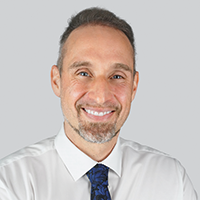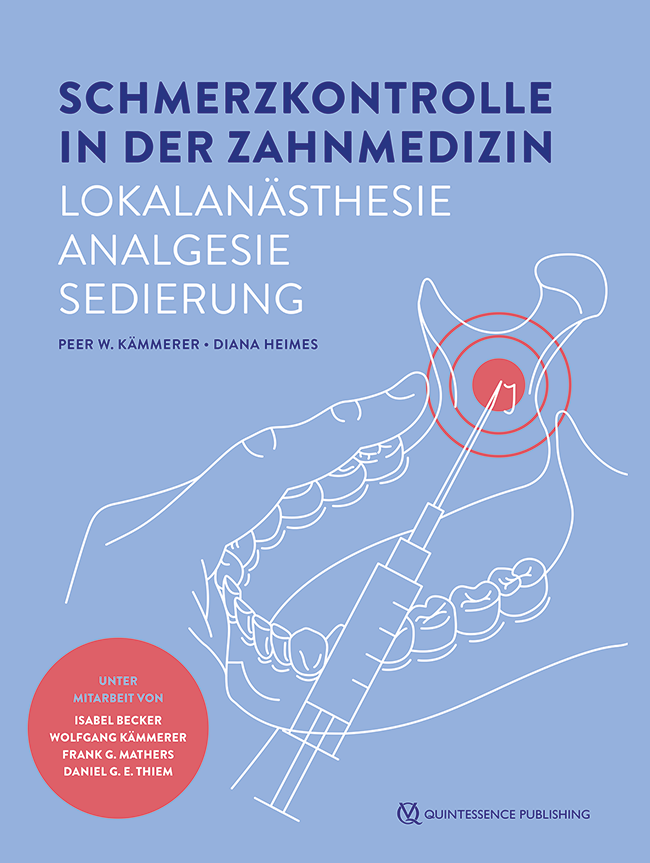Quintessenz Zahnmedizin, 12/2024
Pages 989-994, Language: GermanHeimes, Diana / Kämmerer, Peer W.Die Lokalanästhesie sollte individuell auf den Patienten abgestimmt werden. Der Begriff „Risikopatient“ umfasst nicht nur Menschen mit Vorerkrankungen, sondern auch Kinder, Schwangere und ältere Patienten. Liegen mehrere Erkrankungen vor oder nimmt der Patient mehr als 2 Medikamente ein, steigt das Risiko für Komplikationen signifikant an. Bis zu 44 % der Zahnärzte berichten von mindestens einer systemischen Komplikation pro Jahr, wobei 8 % schwerwiegender Natur sind. Über die Hälfte der betroffenen Patienten hat Begleiterkrankungen, vor allem kardiovaskuläre oder zerebrovaskuläre Beschwerden. Trotz der zunehmenden Zahl von Risikopatienten wird in der Praxis häufig hochkonzentriertes Adrenalin verwendet, obwohl oft geringere Dosen ausreichen. Eine Anästhesie ohne Vasokonstriktor ist bei korrekter Auswahl des Präparats ebenfalls möglich. Zudem können minimalinvasive Injektionstechniken das Risiko systemischer Toxizität zusätzlich verringern. Manuskripteingang: 17.09.2024, Manuskriptannahme: 24.09.2024
Keywords: Lokalanästhesie, kardiovaskuläre Erkrankung, Diabetes mellitus, Lebererkrankung, Nierenerkrankung
Implantologie, 2/2022
Pages 165-174, Language: GermanBlatt, Sebastian / Kämmerer, Peer W.Die antiresorptive Therapie aus onkologischer Indikation oder bei Patienten mit Osteoporose gehört zu den häufigen Begleitmedikationen vieler Patienten. Dabei gilt die medikamentenassoziierte Kiefernekrose („medication-related osteonecrosis of the jaw“, MRONJ) als eine Komplikation, deren Ätiopathogenese bisher nicht geklärt erscheint. Als assoziierte Risikofaktoren, die zur Entwicklung einer Kiefernekrose beitragen, gelten systemische (Komedikation mit Glukokortikoiden oder Chemotherapeutika) und lokale Faktoren wie dentoalveoläre Eingriffe. Die kaufunktionelle Rehabilitation von Patienten unter antiresorptiver Therapie mit implantatgetragenem Zahnersatz wird weiterhin teilweise kontrovers in der Literatur diskutiert. Auf der einen Seite könnte das kompromittierte Knochenlager zu einer insuffizienten Osseointegration und geminderten Implantatüberlebensraten führen. Weiterhin könnten der Eingriff der Implantation oder das Implantat an sich sowie assoziierte Erkrankungen wie die Periimplantitis als auslösende Faktoren für die Entstehung einer MRONJ gesehen werden. Andererseits kann durch implantatgetragenen Zahnersatz das Risiko einer MRONJ durch eine potenzielle Druckstelle der schleimhautgetragenen Prothese gemindert und die Lebensqualität analog zu Patienten ohne antiresorptive Therapie, insbesondere bei zahnlosem Kiefer, gesteigert werden. Eine gute Mundhygiene und entsprechende supportive zahnärztliche Therapie sind bei allen Patienten unter antiresorptiver Behandlung notwendig, insbesondere vor einer etwaigen Implantattherapie. Im Folgenden soll ein kurzer Überblick über die aktuelle Evidenz bezüglich einer dentalen Implantation bei Patienten unter antiresorptiver Therapie gegeben werden. Einzelne Zusammenhänge zwischen Dosierung und Medikationsindikation und Entwicklung einer Kiefernekrose nach Implantation sollen ebenso wie das Implantatüberleben in diesem speziellen Patientenkollektiv im Kontext der aktuellen Literatur betrachtet werden. Ziel ist es, die patientenindividuelle Risikoabschätzung und Therapieentscheidung im klinischen Alltag stützen zu können.
Manuskripteingang: 21.03.2022, Annahme: 18.05.2022
Keywords: Bisphosphonate, RANKL-Inhibitor, medikamentenassoziierte Kiefernekrose, Implantatüberleben
Quintessenz Zahnmedizin, 7/2021
ImplantologiePages 782-793, Language: GermanTröltzsch, Markus / Kämmerer, Peer W. / Pabst, Andreas / Tröltzsch, Matthias / Kauffmann, Philipp / Schiegnitz, Eik / Brockmeyer, Phillipp / Al-Nawas, BilalEine visualisierte Darstellung für den AlltagFür den Implantaterfolg ist eine ausreichende knöcherne und weichgewebige Grundlage die Voraussetzung. Bei einer Zahnextraktion oder bei bestehenden Defiziten des Alveolarkammes stehen verschiedene Techniken und Materialien zu Verfügung, um den Kieferknochen zu erhalten oder zu augmentieren. Die S2k-Leitlinie „Implantologische Indikationen für die Anwendung von Knochenersatzmaterialien“ (AWMF-Reg.-Nr. 083-009) bietet eine Übersicht und Handlungsanleitung. Im vorliegenden Beitrag sollen nun die Inhalte der Leitlinie anhand von konkreten Fällen alltagsgerecht vorgestellt werden.
Keywords: Augmentation, Leitline, Sinuslift, „Ridge preservation“, Implantat, Knochenersatzmaterial
Dentista, 4/2021
FokusPages 22-25, Language: GermanSchneider, Sarah / Schneider, Daniel / Kämmerer, Peer W.Was kann passieren und was ist im Notfall zu tun?Der demografische Wandel nimmt zunehmend Einfluss auf die zahnärztliche Praxis. Die Zahl älterer, chronisch kranker Patienten mit einer erhöhten Medikamenteneinnahme nimmt folglich zu. Die Zahl an Komplikationen steigt mit Multimorbidität und Polypharmazie des Patienten. Es ist essenziell notwendig, durch eine gründliche Anamnese den Gesundheitszustand des Patienten zu kennen und damit das Wissen über seine potenziellen Risiken zu haben. Das gilt auch für die wohl häufigste Behandlung in der Zahnmedizin: die Injektion eines Lokalanästhetikums.
Deutsche Zahnärztliche Zeitschrift, 3/2021
GesellschaftDOI: 10.3238/dzz.2021.0014Pages 180, Language: GermanTröltzsch, Markus / Kämmerer, Peer W. / Pabst, Andreas / Tröltzsch, Matthias / Kauffmann, Philipp / Schiegnitz, Eik / Brockmeyer, Phillippp / Al-Nawas, BilalDer Ersatz fehlender Zähne nach nicht vermeidbarem Zahnverlust ist eine zahnärztliche Kernkompetenz. Neben der offensichtlichen kaufunktionellen und ästhetischen Rehabilitation stehen immer mehr auch medizinische Überlegungen, die den Ersatz fehlender Zähne rechtfertigen könnten.
Das spätere Implantatlager wird allerdings häufig durch beim Zahnverlust ausgelöste oder danach entstandene Defekte des Alveolarfortsatzes kompromittiert. Der Erhalt und gegebenenfalls die Regeneration des Alveolarfortsatzes spielt daher im klinischen Alltag eine große Rolle. Für den Behandler stehen hier neben autogenem Knochen verschiedene Biomaterialien zur Verfügung. In der Leitlinie "Implantologische Indikationen für die Anwendung von Knochenersatzmaterialien" der DGI und DGZMK wurden folgende Fragestellungen adressiert: 1. Welche Indikationen bestehen für die Knochenaugmenta-tion, 2. Welche Materialien stehen zur Verfügung, 3. Welche Techniken werden empfohlen?
Im Folgenden werden nun die wissenschaftlichen Kernaussagen der Leitlinie zusammengefasst. Die Literaturangaben sind somit auf dieses Format angepasst, die vollen Angaben und Hintergründe finden Sie in der Leitlinie.
Keywords: Kieferatrophie, Knochenaugmentation, Knochenersatzmaterialien, Knochentransplantate, Zahnverlust
DZZ International, 3/2021
Open Access Online OnlyGuidelineDOI: 10.3238/dzz-int.2021.0015Pages 129, Language: EnglishTröltzsch, Markus / Kämmerer, Peer W. / Pabst, Andreas / Tröltzsch, Matthias / Kauffmann, Philipp / Schiegnitz, Eik / Brockmeyer, Philipp / Al-Nawas, BilalThe replacement of missing teeth after unavoidable tooth loss is a core competence in dentistry. In addition to the obvious rehabilitation of the masticatory function and esthetics, there are increasingly more medical considerations that might warrant the replacement of missing teeth.
However, the prospective implant site is often compromised by defects of the alveolar process which are triggered by tooth loss or which develop after extraction. The preservation and, if necessary, the regeneration of the alveolar process thus play a major role in daily clinical practice. Various biomaterials are available to the dental practitioner besides autologous bone grafts. The following questions were addressed in the guideline "Implantological indications for the use of bone substitute materials" of the DGI and DGZMK: 1. which are the indications for bone augmentation, 2. which materials are available, 3. which techniques are recommended?
The key scientific statements of the guideline are summarized below. The literature references are therefore adapted to this format. The complete details and background are found in the guideline.
Keywords: bone augmentation, bone grafts, bone substitutes, jaw atrophy, tooth loss
Quintessence International, 4/2020
DOI: 10.3290/j.qi.a44149, PubMed ID (PMID): 32128527Pages 318-327, Language: EnglishPabst, Andreas / Kämmerer, Peer W.Free mucous membrane grafts and connective soft tissue grafts have been considered the gold standard in oral soft tissue regeneration for a long period of time. Due to the morbidity while harvesting autogenous soft tissue grafts, xenogeneic collagen matrices of porcine origin were recently developed. Next to soft tissue regeneration, these collagen matrices have also been reported to be suitable for bone regeneration in the context of bone graft stabilization and shielding techniques. Collagen matrices are classed as medical devices, and are produced in a complex treatment and cleaning process. With respect to the individual area of indication, collagen matrices are produced from porcine dermis, pericardium, or peritoneum. The advantages and limitations of collagen matrices in comparison to autogenous soft tissue grafts in the different indication areas are controversially discussed. There might be evidence that these collagen matrices are able to reach similar outcomes to autogenous soft tissue grafts in certain indications. Currently, a final assessment of this relevant question is not possible cause of a lack of evidence-based data.
Originally published (in German) in Quintessenz Zahnmedizin 2019;70:64–76)
Keywords: acellular, barrier matrix, collagen matrix, collagen type I/III, guided bone regeneration, guided tissue regeneration, porcine scaffold, remodeling matrix, xenogeneic matrix
Quintessenz Zahnmedizin, 1/2019
ImplantologiePages 64-76, Language: GermanPabst, Andreas / Kämmerer, Peer W.Freie Schleimhaut- und Bindegewebetransplantate galten lange Zeit als der unangefochtene Goldstandard im Rahmen der Weichgeweberegeneration. Aufgrund der Entnahmemorbidität dieser autologen Transplantate wurden Kollagenmembranen xenogenen, meist porcinen Ursprungs entwickelt. Sie eignen sich neben der Weichgeweberegeneration im Sinne einer Remodellierungsmembran als Ersatz für freie Schleimhaut- und Bindegewebetransplantate auch zur Hartgeweberegeneration im Sinne einer Stabilisierungs- und Barrieremembran. Bei diesen Kollagenmembranen handelt es sich um Medizinprodukte, die in einem komplexen Aufbereitungsprozess je nach Hersteller und Indikationsbereich aus der Dermis, dem Perikard oder dem Peritoneum des Schweins gewonnen werden. Die möglichen Vor- und Nachteile von Kollagenmembranen gegenüber autologen Transplantaten in den verschiedenen Indikationsbereichen werden derzeit kontrovers diskutiert, wobei die Kollagenmembranen den autologen Transplantaten in einigen Indikationen zumindest ebenbürtig zu sein scheinen. Eine abschließende, evidenzbasierte Beurteilung ist derzeit noch nicht möglich.
Keywords: Kollagenmembran, Kollagen Typ I/III, xenogene Matrix, azelluläre Matrix, porcine Kollagenmembran, Barrieremembran, Remodellierungsmembran
The International Journal of Oral & Maxillofacial Implants, 1/2019
DOI: 10.11607/jomi.6729, PubMed ID (PMID): 30282092Pages 133-140a, Language: EnglishThiem, Daniel G. E. / Adam, Martin / Ganz, Cornelia / Gerber, Thomas / Kämmerer, Peer W.Purpose: This study aimed to evaluate whether different surface modifications affect the dynamics of bone remodeling at the implant and the adjacent local bone.
Materials and Methods: Seventy-two dental implants with different surfaces (smooth and rough control [smCtrl; rCtrl], smooth and rough + O2-plasma spray [smPlas; rPlas], smooth and rough + nanocrystalline SiO2-hydroxyapatite coating [ncSiO2HA] + O2-plasma spray [smNB-C; rNB-C]; each n = 12) were bilaterally inserted into the femora of 36 New Zealand white rabbits. Intravital fluorochrome labeling was performed to visualize the dynamics of bone formation. The objectives were quantification of bone-to-implant contact (BIC [%]) at 2 and 4 weeks and the dynamic bone formation (dbf [%]) at the implants' adjacent local bone within 1, 2, and 3 weeks.
Results: After 2 weeks, BIC was significantly higher for both smNB-C (BIC: 59% ± 2% SEM) and rNB-C (BIC: 66% ± 3% SEM) compared with controls (BIC: 42% ± 1% SEM; P .005). After 4 weeks, BIC for rNB-C (65% ± 2%) was superior to all test groups (BIC: 39% ± 2% SEM; P = .012). Regarding dbf (%), neither within 1 (P = .88), 2 (P = .48), nor after 3 weeks (P = .36) did any differences occur among the groups, even in accordance to the implant level.
Conclusion: Although distance osteogenesis seems crucial for the development of secondary stability, and thus, of osseointegration, it apparently is not affected by a bioactive ncSiO2HA surface coating. Changing the surfaces' release kinetics and composition may increase distance osteogenesis.
Keywords: adjacent bone formation, distance osteogenesis, intravital labeling, ncSiO2HA-coating, secondary stability, surface modification
International Poster Journal of Dentistry and Oral Medicine, 5/2018
SupplementPoster 1223, Language: EnglishHildebrandt, Helmut / Kämmerer, Peer W. / Seiler, Marcus / Hartmann, Amely GundulaResults of a Clinical StudyManagement of defects of the jaw bone and consecutive implant placement is still a challenge in daily practice. Patient-specific titanium meshes are a promising tool to create optimal patient care. With this study, the surgical protocol was analyzed for feasibility and evaluated to identify risk factors concerning soft tissue healing according to a new classification for mesh exposure.
Keywords: Titanium meshes, customized bone regeneration, dehiscences, implant placement




